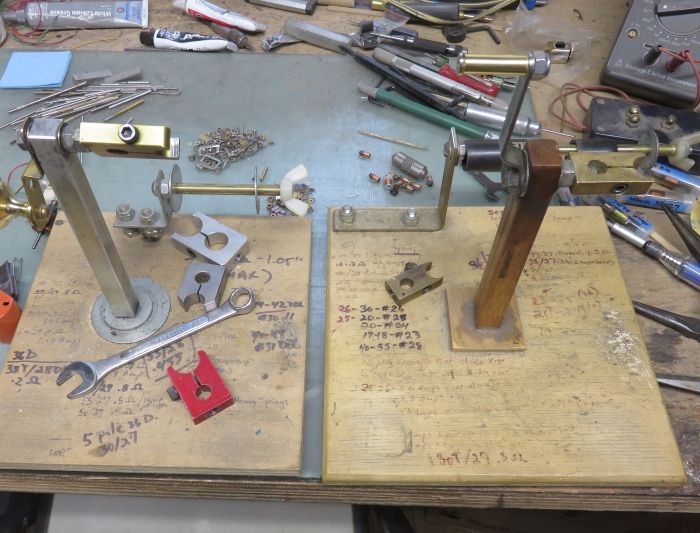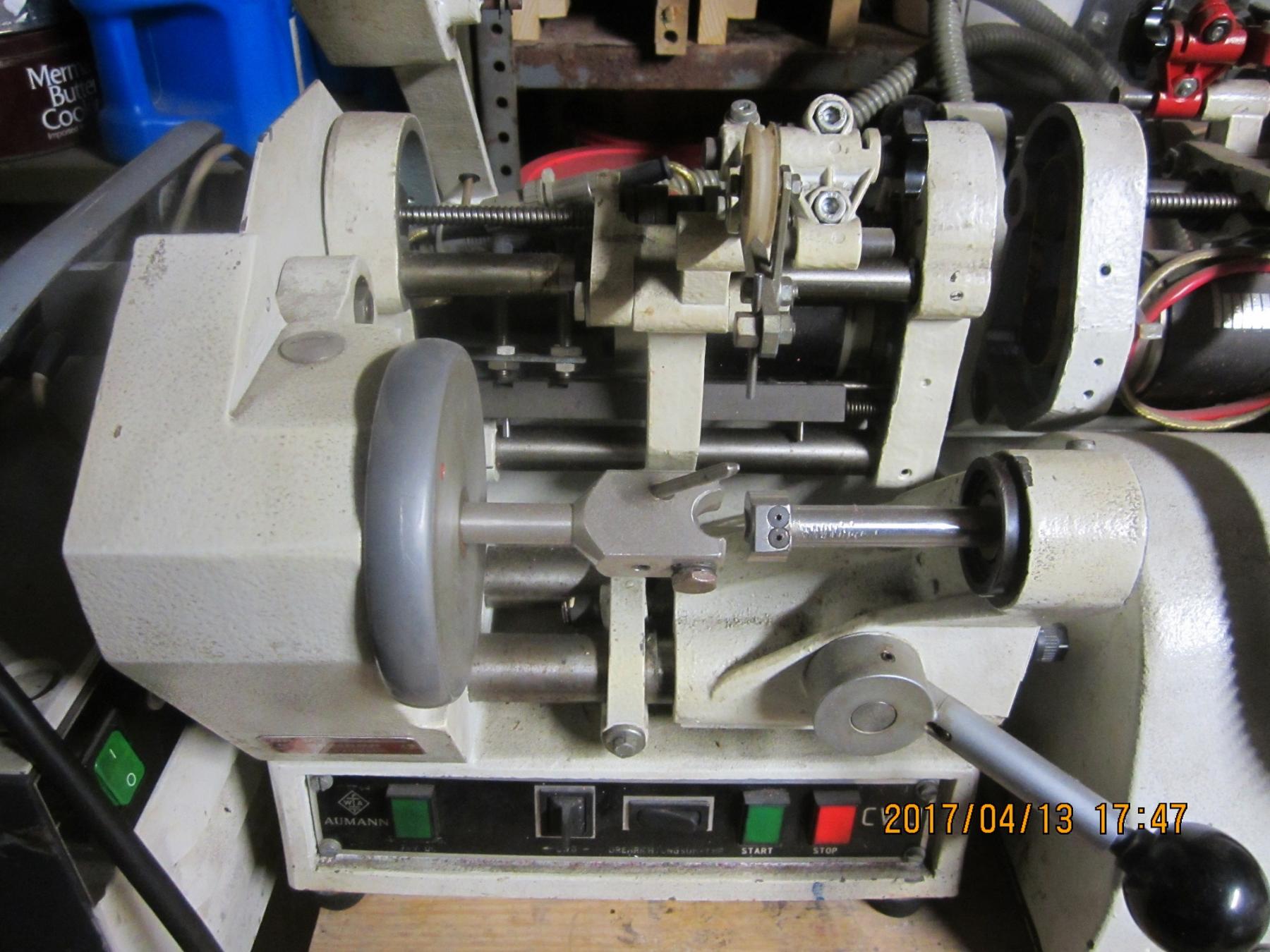I'm certain that I've read postings about clamps "It's all about the clamp" or something similar. Any leads to this topic would be greatly appreciated!

Arm winding clamps
#1

Posted 06 May 2017 - 05:45 AM
#2

Posted 06 May 2017 - 06:23 AM
- olescratch and Geary Carrier like this
#3

Posted 11 May 2017 - 10:42 AM
Johns post about the clamp is great but I had trouble finding a winder.But I found a winder at Micheal's craft store for winding jewelry that will work quite well in case you are looking.It is in the section where they sell the tools for making wire beaded jewelry ![]()
#4

Posted 11 May 2017 - 01:18 PM
Johns post about the clamp is great but I had trouble finding a winder.But I found a winder at Micheal's craft store for winding jewelry that will work quite well in case you are looking.It is in the section where they sell the tools for making wire beaded jewelry
Pictures please!!
#5

Posted 11 May 2017 - 02:13 PM
#6

Posted 11 May 2017 - 03:38 PM
I can't see how this tool would be useful in doing the type of winding that's done with our type of motors!!??
#7

Posted 11 May 2017 - 05:02 PM
#8

Posted 11 May 2017 - 08:52 PM
Paul, I've messed around with a couple similar jewelry winders at a Jo-Ann Fabrics store. In my opinion, neither was built robust enough to wind arms, providing one came up with a good way to hold an arm. One of the Aussie slot boards shows a winder constructed from K&S brass & wire. I would imagine one could also cobble a winder together using a hardwood, such as oak or maple & some hardware.(screws & bolts)
I intend to live forever! So far, so good.
#9

Posted 11 May 2017 - 10:27 PM
The question was asked for a picture of the winder and I linked to what I found doing a search.
Either a Laganke RGeo or self built seems much more beefy & up to the task.
- olescratch likes this
#10

Posted 12 May 2017 - 05:27 AM
The winding crank itself can be made out of about anything, and it's dead-simple to make one up out of whatever is lying around. It's the clamp that needs to be made by someone who knows their way around machine tools. My most-used crank has pieces of door hardware soldered together with a bolt, and uses a piece of scrap mahogany as the post. I have two cranks and both of them are mounted to a small piece of thin plywood that can be secured to a table or workbench edge using squeeze clamps...MUCH better than putting the post in a vise. I DO have a LaGanke crank around here somewhere, but haven't used that because it would take some fidgeting to attach it to a board. Anyway, the one thing *for me* that I find useful is to be able to dial-in some resistance on the crank. A crank that simply rotates and will fall causes difficulties. I like the crank to be able to stay in any position when I take my hand off it, so I use a blot for the crank "axle" with a jam-nut. I can then slightly tighten the nut so the crank has some resistance. This also make the crank and clamp work as a nifty way to hold the arm when I'm brazing the com connections.
#11

Posted 12 May 2017 - 07:56 PM
I also have the LaGanke winder, but felt it necessay to build one with the addition of a counter. I'm already thinking of how to build #2. The next one will include a jam nut, you already know why lol!! I only asked for a pic of the one mentioned above to see how durable it could have possibly been since it was designed to make jewlery! Thanks to all that replied.
#12

Posted 13 May 2017 - 06:24 AM
The next one will include a jam nut, you already know why lol!!
For sure. Most all of the old winding cranks (including the LaGanke) used a circlip that prevented the crank arm from moving laterally, but the crank would just flop when you took your hand off the handle. Being able to dial-in some resistance makes it sooo much easier to wind, it's interesting that none of the ones I've seen included that function. Resistance also makes it easier to tension the wire, because as you're turning, there's less of the natural "tight/loose" thing going on, that naturally tends to happen with a free-turning crank. Again as I mentioned earlier, the same winding crank and clamp also make a dandy way to hold the arm when making the com connections...IF...the arm will stay put and not just flop.
#13

Posted 13 May 2017 - 11:42 AM
Are there any pics of the winders Koford and Pro Slot use? I'd be interesting to see what the manufacturers use.
???-2/31/23
Requiescat in Pace
#14

Posted 13 May 2017 - 05:27 PM
Here is a photo of the RJR CNC armature winder. Requires a new computer and driver upgrade -
too much money for too little demand in the current market.
This is the mechanical end of it.
#16

Posted 14 May 2017 - 08:22 AM
Wow! I wasn't expecting anything that sophisticated. Thanks for posting that.
???-2/31/23
Requiescat in Pace
#17

Posted 14 May 2017 - 01:17 PM
I hear you Bill
The question was asked for a picture of the winder and I linked to what I found doing a search.
Either a Laganke RGeo or self built seems much more beefy & up to the task.
The link was not the tool I saw although they sold that one too.The one I'm talking about was 34.95 and looked more like this http://www.artbeads....-Uk0aApVQ8P8HAQ
But I cant find it at the moment.It was taller than the one in this link had a longer crank arm, also it used a drill chuck and had a jam nut located in the hub to lock it in place and or add some preload.If I remember I'll take a look in my local store for it as it was right next to the purple boxed tools that was linked earlier.
As soon as I find it I'll link it because it was a nice tool.Essentially all you had to do was clamp it to the table and add the armature clamp to the drill chuck and you were off to the races.

















